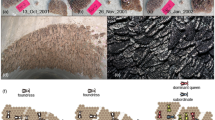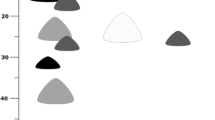Abstract
In temperate climates, female paper wasps typically initiate new colonies in the spring. Several nest-founding tactics have been documented in Polistes species, including solitary nest initiation, joining a cooperative association, usurping an existing nest, or adopting an abandoned nest. Occasionally, exceptionally large groups of females have also been found reusing nests from the previous season. Here we report this phenomenon in introduced populations of the Eurasian species Polistes dominulus. We describe in detail the demographic and genetic characteristics of one such spring colony from Los Angeles, California, USA, which was collected with 84 associated adults and all stages of developing brood in its 613 cells. Genetic and morphological data indicate the presence of multiple reproductively active females of varying relatedness, as well as many nonbreeding females, including probable early-produced offspring. Despite some evidence of chaotic social conditions, the colony appeared to have been highly productive. Additional observations of similar colonies are needed to determine how control is maintained within such a large breeding aggregation.
Similar content being viewed by others
References
Cant MA, English S (2006) Stable group size in cooperative breeders: the role of inheritance and reproductive skew. Behav Ecol 17:560–568
Cant MA, Field J (2001) Helping effort and future fitness in cooperative animal societies. Proc R Soc Lond B 268:1959–1964
Cant MA, Llop JB, Field J (2006) Individual variation in social aggression and the probability of inheritance: theory and a field test. Am Nat 167:837–852
Cervo R, Zacchi F, Turillazzi S (2000) Polistes dominulus (Hymenoptera, Vespidae) invading North America: some hypotheses for its rapid spread. Insect Soc 47:155–157
Cumber RA (1951) Some observations on the biology of the Australian wasp Polistes humilis Fabr. (Hymenoptera: Vespidae) in North Auckland (New Zealand), with special reference to the nature of the worker caste. Proc R Entomol Soc 26:11–16
Eickwort GC (1978) Polistes dominulus discovered near Boston. Polistine Information Bulletin Newsletter
Faulkes CG, Bennett NC (2001) Family values: group dynamics and social control of reproduction in African mole-rats. Trends Ecol Evol 16:184–190
Fukatsu T (1999) Acetone preservation: a practical technique for molecular analysis. Molec Ecol 8:1935–1945
Giovanetti M, Cervo R, Turillazzi S (1996) Comb reutilization in Polistes dominulus (Hymenoptera: Vespidae). In Le Moli F, Mori A, Grasso D (eds) Insect social life, pp 101–105
Goodnight KF, Queller DC (1999) Relatedness, version 5.0.8. Goodnight Software, Houston
Guiglia D (1972) Les Guêpes Sociales (Hymenoptera Vespidae) d'Europe Occidentale et Septentrionale. Masson et Cie, Paris
Henshaw MT (2000) Microsatellite loci for the social wasp Polistes dominulus and their application in other polistine wasps. Molec Ecol 9:2155–2234
Itô Y (1986) Spring behaviour of an Australian paper wasp, Polistes humilis synoecus: colony founding by haplometrosis and utilization of old nests. Kontyû 54:191–202
Jacobson RS (1991) Polistes dominulus spreading in USA. Sphecos 21:14
Johnson RN, Starks PT (2004) A surprising level of genetic diversity in an invasive wasp: Polistes dominulus in the northeastern United States. Ann Entomol Soc Am 97:732–737
Konovalov DA, Manning C, Henshaw MT (2004) KinGroup: a program for pedigree relationship reconstruction and kin group assignments using genetic markers. Molec Ecol Notes 4:779–782
Liebert AE, Starks PT (2006) Taming of the skew: transactional models fail to predict reproductive partitioning in the paper wasp Polistes dominulus. Anim Behav 71:913–923
Liebert AE, Nonacs P, Wayne RK (2005a) Solitary nesting and reproductive success in the paper wasp Polistes aurifer. Behav Ecol Sociobiol 57:445–456
Liebert AE, Sumana A, Starks PT (2005b) Diploid males and their triploid offspring in the paper wasp Polistes dominulus. Biol Lett 1:200–203
Liebert AE, Gamboa GJ, Stamp NE, Curtis TR, Monnet KM, Turillazzi S, Starks PT (2006) Genetics, behavior and ecology of a paper wasp invasion: Polistes dominulus in North America. Ann Zool Fennici 43:595–624
Liebig J, Monnin T, Turillazzi S (2005) Direct assessment of queen quality and lack of worker suppression in a paper wasp. Proc R Soc Lond B 272:1339–1344
Nonacs P, Reeve HK (1993) Opportunistic adoption of orphaned nests in paper wasps as an alternative reproductive strategy. Behav Proc 30:47–60
Nonacs P, Liebert AE, Starks PT (2006) Transactional skew and assured fitness return models fail to predict patterns of cooperation in wasps. Am Nat 167:467–480
Oster GF, Wilson EO (1978) Caste and ecology in the social insects. Princeton University Press, Princeton, NJ
Queller DC, Zacchi F, Cervo R, Turillazzi S, Henshaw MT, Santorelli LA, Strassmann JE (2000) Unrelated helpers in a social insect. Nature 405:784–786
Rabb RL (1950) A contribution to the ecology of Polistes in North Carolina. M.S. Thesis: University of North Carolina
Rau P (1929) Orphan nests of Polistes (Hymenoptera: Vespidae). Entomol News 40:226–232
Reeve HK (1991) Polistes. In: Ross KG, Matthews RW (eds) The social biology of wasps. Cornell University Press, Ithaca, NY, pp 99–148
Shreeves G, Cant MA, Bolton A, Field J (2003) Insurance-based advantages for subordinate co-foundresses in a temperate paper wasp. Proc R Soc Lond B 270:1617–1622
Spradbery JP (1991) Evolution of queen number and queen control. In: Ross KG, Matthews RW (eds) The social biology of wasps. Cornell University Press, Ithaca, pp 336–388
Starks PT (1998) A novel ‘sit and wait’ reproductive strategy in social wasps. Proc R Soc Lond B 265:1407–1410
Strassmann JE (1981) Parasitoids, predators, and group size in the paper wasp, Polistes exclamans. Ecology 62:1225–1233
Strassmann JE (1983) Nest fidelity and group size among foundresses of Polistes annularis. J Kansas Entomol Soc 56:621–634
Strassmann JE (2001) The rarity of multiple mating by females in the social Hymenoptera. Insect Soc 48:1–13
Strassmann JE, Solís CR, Peters JM, Queller DC (1996) Strategies for finding and using highly polymorphic DNA microsatellite loci for studies of genetic relatedness and pedigrees. In: Ferraris J, Palumbi SR (eds) Molecular zoology. Wiley, New York, pp 163–180
Tibbetts EA, Reeve HK (2003) Benefits of foundress associations in the paper wasp Polistes dominulus: increased productivity and survival, but no assurance of fitness returns. Behav Ecol 14:510–514
Turillazzi S (1980) Seasonal variations in the size and anatomy of Polistes gallicus (L) (Hymenoptera, Vespidae). Monit Zool Ital 14:63–75
West-Eberhard MJ (2006) Polistine passions. Ann Zool Fennici 43:387–389
Winston ML (1987) The biology of the honey bee. Harvard University Press, Cambridge
Yamane S (1996) Ecological factors influencing the colony cycle of Polistes wasps. In: Turillazzi S, West-Eberhard MJ (eds) Natural history and evolution of paper-wasps. Oxford University Press, Oxford
Acknowledgements
We thank Smadar Gilboa for help with colony collection, Malvina Liebert for translation of references, and the American Association of University Women postdoctoral fellowship for financial support of A.E. Liebert.
Author information
Authors and Affiliations
Corresponding author
Rights and permissions
About this article
Cite this article
Liebert, A.E., Hui, J., Nonacs, P. et al. Extreme Polygyny: Multi-seasonal “Hypergynous” Nesting in the Introduced Paper Wasp Polistes dominulus . J Insect Behav 21, 72–81 (2008). https://doi.org/10.1007/s10905-007-9108-x
Revised:
Accepted:
Published:
Issue Date:
DOI: https://doi.org/10.1007/s10905-007-9108-x




